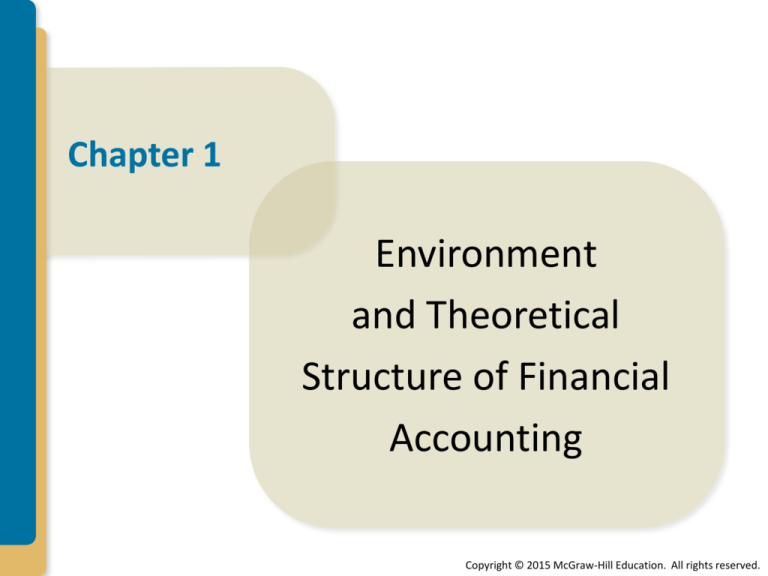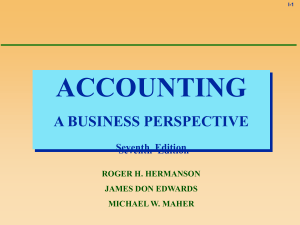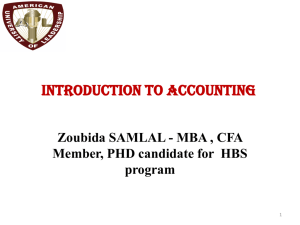
Chapter 1
Environment
and Theoretical
Structure of Financial
Accounting
Copyright © 2015 McGraw-Hill Education. All rights reserved.
LO1-1
Primary Focus of Financial Accounting
• Providing financial information to various external users
– Investors
– Creditors
– Other external users
Investors
&
creditors
Use different kinds of information To predict the
Financial information is a
key component of that
information set
future risk and
potential return of
investments or
loans
Before supplying
capital to
businesses
LO1-1
Financial Accounting
• Financial information is conveyed through financial
statements and related disclosure notes
–
–
–
–
Balance sheet
Income statement
Statement of cash flows
Statement of shareholders’ equity
Financial Reporting
• Refers to the process of providing financial information
to external users
LO1-1
Financial Information Providers and External
User Groups
LO1-1
The Economic Environment and Financial
Reporting
Capital markets provide a mechanism to help the
economy allocate resources efficiently
Initial market transactions involve issuance of stocks and
bonds by the corporation
– Corporations receive new cash
Secondary market transactions involve the transfer of
stocks and bonds between individuals and institutions
– Corporations receive no new cash
Corporations acquire capital from investors in exchange
for ownership interest and from creditors by borrowing
LO1-1
The Investment-Credit Decision—
A Cash Flow Perspective
Why do investors and creditors provide capital?
• They want to earn a fair return on the resources they
provide
• Shareholders receive cash from:
– Sale of the ownership shares of stock
– Periodic dividends
Key variables in investment decision
• Rate of return
• Uncertainty or risk
LO1-1
The Investment-Credit Decision—
A Cash Flow Perspective
Example calculation of rate of return:
If an investor provides a company with $10,000 cash by
purchasing stock at the end of 2015, receives $400 in
dividends from the company during 2016, and sells the
ownership interest (shares) at the end of 2016 for
$10,600.
$400 dividends + $600 share price appreciation
$10,000 initial investment
= 10%
• Investors and creditors like to invest in stocks or bonds
that provide a high expected rate of return
Concept Check √
Creecher purchased $200,000 worth of Troman stock , received four
quarterly dividends of $1,000 each, and sold the Troman shares for
$206,000 after one year. What is Creecher’s rate of return?
a. 1%.
b. 2.5%.
c. 5%.
d. 10%.
((4 x $1,000) + ($206,000 - $200,000)) ÷ $200,000 = 5%
LO1-1
The Investment-Credit Decision—
A Cash Flow Perspective
Example of uncertainty (risk): consider the following
two investment options. Which would you pick?
• Investing $10,000 in a savings account insured by
the U.S. government that will generate a 5% rate of
return
• Investing $10,000 in a profit-oriented company
Risk/Return tradeoff: Most investors would invest
in the profit-oriented company only if the
potential return is high enough.
LO1-1
The Investment-Credit Decision—
A Cash Flow Perspective
Primary objective of financial accounting
• Provided information should be useful for decision
making
• Information should help investors and creditors
evaluate
– Amounts
– Timing
– Uncertainty
LO1-2
Cash versus Accrual Accounting
Cash Basis Accounting
• Measurement of cash receipts and cash payments
from transactions related to providing goods and
service
• Difference is net operating cash flow
Accrual Basis Accounting
• Measurement of revenues and expenses, regardless of
when cash is received or paid
• Difference is net income or net loss
Example of Cash Basis Accounting
Example of Accrual Accounting
LO1-2
Concept Check √
Which of the following is not an advantage of accrual accounting?
a. Spreads out the influence of one-time events that affect multiple
reporting periods.
b. Highlights cash effects of operations.
c. Captures long-run performance.
d. Recognizes assets and liabilities associated with receivables and
payables.
Cash-based accounting focuses on cash in and cash out,
and so highlights the cash effects of ongoing operations.
LO1-3
The Development of Financial Accounting
and Reporting Standards
Generally Accepted Accounting Principles (GAAP)
• GAAP is a set of both broad and specific guidelines that
companies should follow when measuring and
reporting the information in their financial statements
and related notes
• GAAP is set by standard setters but also emerges from
practice
• GAAP facilitates decision making by investors and
creditors by helping them understand information and
enhancing the comparability of that information
among companies
LO1-3
Accounting Standard Setting
HIERARCHY OF STANDARD-SETTING AUTHORITY
Congress
SEC
Private Sector
CAP
APB
FASB
1938–1959
1959–1973
1973–Present
LO1-3
Historical Perspective and Standards
Securities and Exchange Commission (SEC)
• Created by Congress in response to the stock market
crash of 1929
– Goal: To restore investor confidence
• 1933 Securities Act
– Applies to initial offerings of securities (stocks and
bonds)
• 1934 Securities Exchange Act
– Applies to secondary market transactions
– Mandates reporting requirements for companies whose
securities are publicly traded
LO1-3
Early U.S. Standard Setting
Committee on Accounting Procedure (CAP) (1938 to 1959)
• First private sector standard-setting body
• Committee of the American Institute of Accountants(AIA)
• AIA: National professional organization for certified
professional public accountants
• AIA: Renamed as American Institute of Certified Public
Accountants (AICPA)
• Issued 51 Accounting Research Bulletins (ARBs)
Accounting Principles Board (APB) (1959 to 1973)
• Issued 31 Accounting Principles Board Opinions (APBOs),
various Interpretations, and four Statements
• Replaced by Financial Accounting Standards Board (FASB)
LO1-3
Financial Accounting Standards Board (FASB)
FASB created in 1973
• Established to set U.S. accounting standards
• Supported by Financial Accounting Foundation (FAF)
• Seven full-time members
Emerging Issues Task Force (EITF) created in 1984
• Identifies financial reporting issues and attempts to
resolve them without involving the FASB
– primarily addresses implementation issues
– speeding up the standard-setting process
• EITF rulings are ratified by the FASB and are considered
part of GAAP
Government Accounting Standards Board (GASB):
develop accounting standards for governmental units such
as states and cities.
Concept Check √
Accounting standards in the United States are currently set by:
a. The FASB.
b. The AICPA.
c. The EITF.
d. The NCAA.
Since 1973, the FASB has been the primary standard-setting
body in the United States.
LO1-3
Codification
FASB Accounting Standards Codification (www.fasb.org)
Only source of authoritative nongovernmental U.S. GAAP
• Organizes the thousands of U.S. GAAP pronouncements
into roughly 90 accounting topics
• Also includes portions of SEC accounting guidance
• Accounting Standards Update (ASU): any new
standard issued by FASB
LO1-3
FASB Accounting Standards Codification Topics
LO1-3
International Standard Setting
International Accounting Standards Committee (IASC)
• Formed in 1973 to develop global accounting standards
• Created a new standard-setting body called the
International Accounting Standards Board (IASB) (2001)
IASB:
• To develop a single set of high-quality, understandable,
and enforceable global accounting standards
• Issued and endorsed 41 International Accounting Standards
(IASs)
• Issued new standards of its own—called International
Financial Reporting Standards (IFRSs)
LO1-3
Comparison of Organizations of U.S. and
International Standard Setters
LO1-3
Efforts to Converge U.S. And International
Standards
U.S. GAAP
IFRS
Converged
Standards
LO1-3
Efforts to Converge U.S. And International
Standards
• September 2002: FASB and IASB signed the Norwalk
Agreement pledging to remove existing differences
between their standards and to coordinate their future
standard-setting agendas
• December 2007: The SEC signalled its view that IFRS
are of high quality by removing reconciliation
requirements
• April 2008: FASB and IASB agreed to accelerate the
convergence process and focus on a subset of key
convergence projects
LO1-3
Efforts to Converge U.S. And International
Standards
• November 2008: SEC issued a Roadmap that listed
necessary conditions to be achieved before the U.S. will
shift to requiring use of IFRS by public companies
• November 2011: The SEC issued two studies —
identified key differences between U.S. GAAP and IFRS
and analyzed how IFRS are applied globally
• July 2012: The SEC staff issued its Final Staff Report
•
Concluded it is not feasible for the U.S. to adopt IFRS
due to:
–
–
–
need for the U.S. to have stronger influence on the
standard-setting process
high costs to companies of converting to IFRS
the fact that many laws, regulations and private
contracts reference U.S. GAAP
LO1-4
The FASB’s Standard-Setting Process
LO1-4
Examples of Politics in Standard Setting
• Mid-1990’s—accounting for employee stock
options
• Accounting for business combinations
• Implementation of the fair value accounting
standard issued in 2007
LO1-5
Encouraging High-Quality Financial Reporting
Role of an Auditor
• Offer credibility to financial statements
• Express an opinion on the compliance of financial
statements with GAAP
• Licensed by states to provide audit services — Certified
public accountants (CPAs)
LO1-5
Financial Reporting Reform
Accounting scandals
Enron
WorldCom
Xerox
Merck
Adelphia Communications
Increased the pressure on lawmakers to pass measures
that would restore credibility and investor confidence in
the financial reporting process
Sarbanes-Oxley Act
LO1-5
Sarbanes-Oxley Act
• Oversight board
• Corporate executive accountability
• Nonaudit services
• Retention of work papers
• Auditor rotation
• Conflicts of interest
• Hiring of auditor
• Internal control
LO1-5
A Move Away from Rules-Based Standards?
Principles-based vs. Rules-based
Objectives-oriented
• A principles-based, or objectives-oriented, approach to
standard-setting stresses professional judgment, as
opposed to following a list of rules
• Regardless, poor ethical values on the part of
management are at the heart of accounting abuses and
scandals
LO1-5
Ethics and Professionalism
Ethics deals with the ability to distinguish right from wrong
Codes of ethics are provided by:
• American Institute of Certified Public Accountants
(AICPA)
• Institute of Management Accountants (IMA)
• Institute of Internal Auditors (IIA)
LO1-5
Analytical Model for Ethical Decisions
Step 1. Determine the facts of the situation
Step 2. Identify the ethical issue and the stakeholders
Step 3. Identify the values related to the situation
Step 4. Specify the alternative courses of action
Step 5. Evaluate the courses of action specified in step 4 in
terms of their consistency with the values
identified in step 3
Step 6. Identify the consequences of each possible course
of action
Step 7. Make your decision and take any indicated action
Concept Check √
Which of the following is not one of the ways in which high-quality
accounting is encouraged by the U.S. financial reporting system?
a. Accounting standards encourage comparability.
b. Auditors assess whether financial statements are materially misstated.
c. Sarbanes-Oxley instituted reforms designed to improve the quality of
financial reporting.
d. Managers are required to use frameworks for ethical decision making
when deciding how to account for transactions.
Ethical frameworks can be very useful, but managers are not
required to use them.
LO1-6
The Conceptual Framework
• Described as an “Accounting Constitution”
• Provides an underlying foundation for accounting
standards
– Guide the selection of events to be accounted for
– Measurement of those events
– Means of summarizing and communicating them to
interested parties
• Provides structure and direction to financial accounting
and reporting
• Disseminated by FASB through Statements of Financial
Accounting Concepts (SFACs)
The Conceptual Framework
Objective
Qualitative
Characteristics
Constraints
Elements
Financial
Statements
Recognition and
Measurement
Concepts
The Conceptual Framework
Objective
Qualitative
Characteristics
Constraints
Elements
Financial
Statements
Recognition and
Measurement
Concepts
LO1-7
Hierarchy of Qualitative Characteristics of
Financial Information
Decision usefulness
Relevance
Predictive
Value
Faithful Representation
Confirmatory
value
Comparability
(Consistency)
Materiality
Verifiability
Completeness
Timeliness
Cost effectiveness constraint
(benefits exceed costs)
Neutrality
Free from
error
Understandability
Concept Check √
Which of the following is not a component of relevance as defined in the
FASB’s conceptual framework?
a. Free from error.
b. Materiality.
c. Predictive value.
d. Confirmatory value.
Free from error is a component of faithful representation.
Concept Check √
Which of the following is not a component of faithful representation as
defined in the FASB’s conceptual framework?
a. Free from error.
b. Neutrality.
c. Understandability.
d. Completeness.
Understandability is an enhancing characteristic of decision
usefulness.
The Conceptual Framework
Objective
Qualitative
Characteristics
Constraints
Elements
Financial
Statements
Recognition and
Measurement
Concepts
LO1-7
Elements of Financial Statements
•
•
•
•
•
•
•
•
•
•
Assets
Liabilities
Equity (or net assets)
Investments by owners
Distributions to owners
Comprehensive income
Revenues
Expenses
Gains
Losses
LO1-8
Underlying Assumptions
• The economic entity assumption presumes that
economic events can be identified specifically with
an economic entity.
• The going concern assumption anticipates that a
business entity will continue to operate indefinitely.
• The periodicity assumption allows the life of a
company to be divided into artificial time periods to
provide timely information.
• The monetary unit used in U.S. financial
statements is the U.S. dollar.
The Conceptual Framework
Objective
Qualitative
Characteristics
Constraints
Elements
Financial
Statements
Recognition and
Measurement
Concepts
LO1-9
Recognition, Measurement, and Disclosure
Concepts
• Recognition refers to the process of admitting
information into the financial statements
• Measurement is the process of associating numerical
amounts with the elements
• Disclosure refers to the process of including additional
pertinent information in the financial statements and
accompanying notes
• General Recognition Criteria
– Definition, Measurability, Relevance, and Reliability
LO1-9
Revenue Recognition
Revenue: Inflows of assets or settlements of liabilities
resulting from providing a product or service to a customer
FASB recently issued ASU No. 2014-09, which requires that we
recognize revenue when goods or services are transferred to
customers for the amount the company expects to be entitled to
receive in exchange for those goods or services.
Previously, revenue recognition was guided by the realization
principle (two criteria)
– Earnings process is judged to be complete or virtually
complete
– Reasonable certainty as to the collectibility of the asset to
be received (usually cash)
LO1-9
Expense Recognition
Often matches revenues and expenses that arise from the
same transactions or other events
Four approaches:
•
Based on an exact cause-and-effect relationship
•
By associating an expense with the revenues
recognized in a specific time period
•
By a systematic and rational allocation to specific time
periods
•
In the period incurred, without regard to related
revenue
LO1-9
Measurement
GAAP currently employs a “mixed attribute” measurement
model. The five measurement attributes are:
Historical cost: original transaction value adjusted for
depreciation and amortization.
Net realizable value: the amount of cash into which an asset
is expected to be converted in the ordinary course of business
Current cost: the cost that would be incurred to purchase or
reproduce the asset.
Present (or discounted) value: calculated by removing the
time value of money from future cash flows
Fair value: the price that would be received to sell assets or
paid to transfer a liability in an orderly transaction between
market participants at the measurement date.
LO1-9
Measurement
Historical Cost: Original transaction value
• Bases measurements on the amount given or received in
the exchange transactions
For assets:
– Value of what is given in exchange (usually cash) for the
asset at its initial acquisition
For liabilities:
– Current cash equivalent received in exchange for assuming
the liability
Long-lived, revenue-producing assets (equipment):
– Adjusted subsequent to its initial measurement by
recognizing depreciation or amortization
LO1-9
Measurement
Net Realizable Value
• Bases measurements on the amount of cash into which the
asset or liability will be converted in the ordinary course of
business
• Provides useful information to aid in the prediction of
future cash flows
Current Cost
• Some inventories are reported at their current replacement
cost
Present Value (SFAC 7)
• Bases measurement on future cash flows discounted for the
time value of money
LO1-9
Measurement
Fair Value (called current market value originally in SFAC 5 )
• Bases measurements on the price that would be received
to sell assets or transfer liabilities in an orderly market
transaction
Fair value can be measured using:
1. Market approach: Valuation based on market information
2. Income approach: Estimates future amounts and then
mathematically converts those amounts to a single
present value
3. Cost approach: Estimates the amount that would be
required to buy or construct an asset of similar quality and
condition
Concept Check √
Which of the following is not a measurement attribute defined in the FASB’s
conceptual framework?
a. Net realizable value.
b. Historical cost.
c. List price.
d. Fair value.
List price is not a measurement attribute. Rather, it is
whatever sales price a seller indicates (which might be
negotiable or subject to discounts).
LO1-9
Fair Value Hierarchy
Concept Check √
Which of the following is not true?
a. The fair value hierarchy reflects the subjectivity of inputs used to
compute fair values.
b. Level 1 of the fair value hierarchy refers to quoted market prices that
can be directly observed.
c. Level 3 of the fair value hierarchy refers to inputs that are not directly
observable, and so must be based on the entity’s own assumptions.
d. Level 3 inputs are preferred to Level 2, which are preferred to Level 1.
Level 1 inputs are most preferable because they are the least
subjective. Level 3 inputs are the least preferable because
they are based on the entity’s own assumptions.
LO1-9
Measurement
Fair Value Option
• GAAP gives a company the option to report some
financial assets and liabilities at fair value
– Provides companies a way to reduce volatility in
reported earnings without having to comply with
complex hedge accounting standards
– Helps to converge with international accounting
standards
LO1-9
Disclosure
Full-disclosure principle: requires that the financial reports
should include any information that could affect the
decisions made by external users
Such information can be disclosed in a variety of ways:
• Parenthetical comments or modifying comments
– Placed on the face of the financial statements
• Disclosure notes
– Convey additional insights
• Supplemental schedules and tables
– Report more detailed information than is shown in the
primary financial statements
Summary of Recognition, Measurement, and
Disclosure Concepts
LO1-9
LO1-10
Evolving GAAP
• Revenue/Expense Approach
– Emphasize principles for recognizing revenues and
expenses, which determines amount and timing of
recognition of assets and liabilities
• Asset/Liability Approach
– Recognize and measure the assets and liabilities that
exist at a balance sheet date
– Recognize and measure the revenues, expenses, gains
and losses needed to account for the changes in these
assets and liabilities from the previous measurement
date
LO1-11
International Financial Reporting Standards
Role of the conceptual framework
IFRS
Guides standard setting,
but in addition it is supposed
to provide a basis for
practitioners to make
accounting judgments
Emphasizes that financial
statements should provide a
“true and fair representation”
of the company
U.S GAAP
Primarily provides
guidance to standard
setters to help them
develop high-quality
standards
Does not include an
explicit requirement, but
U.S. auditing standards
require this consideration
End of Chapter 1






